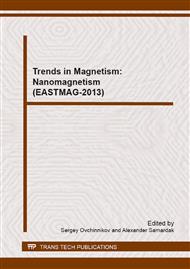p.163
p.167
p.173
p.179
p.185
p.190
p.196
p.200
p.204
Structure Evolution of Fe- and Co-Based Amorphous Alloys Studied by the Electrical Resistivity Measurements
Abstract:
The subject of this study is the change of the electrical resistivity of Fe-based metallic glasses during heat treatment. Electrical resistivity is a structure-sensitive characteristic of materials. In metallic glasses, the scattering of conduction electrons on the disordered structure is the main mechanism responsible for the electrical resistivity. Hence amorphous metallic alloys have a much higher residual resistivity as compared to their crystalline analogs. It is typical for metallic glasses that the temperature coefficient of resistivity (TRC) is smaller than for the corresponding crystalline materials, and it can be either positive or negative.
Info:
Periodical:
Pages:
185-189
Citation:
Online since:
April 2014
Price:
Сopyright:
© 2014 Trans Tech Publications Ltd. All Rights Reserved
Share:
Citation:


